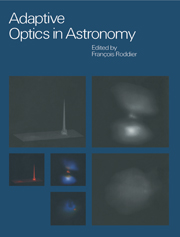Book contents
- Frontmatter
- Contents
- List of contributors
- Part one Introductory background
- 1 Historical context
- 2 Imaging through the atmosphere
- Part two The design of an adaptive optics system
- Part three Adaptive optics with natural guide stars
- Part four Adaptive optics with laser beacons
- Part five The impact of adaptive optics in astronomy
- Glossary of acronyms
- Index
1 - Historical context
from Part one - Introductory background
Published online by Cambridge University Press: 23 November 2009
- Frontmatter
- Contents
- List of contributors
- Part one Introductory background
- 1 Historical context
- 2 Imaging through the atmosphere
- Part two The design of an adaptive optics system
- Part three Adaptive optics with natural guide stars
- Part four Adaptive optics with laser beacons
- Part five The impact of adaptive optics in astronomy
- Glossary of acronyms
- Index
Summary
Turbulence in the Earth's atmosphere produces inhomogeneities in the air refractive index, which affect the image quality of ground-based telescopes. Adaptive optics (AO) is a means for real time compensation of the image degradation. The technique was first proposed by Babcock (1953) and later independently by Linnick (1957) to improve astronomical images. It consists of using an active optical element such as a deformable mirror to correct the instantaneous wave-front distortions. These are measured by a device called a wave-front sensor which delivers the signals necessary to drive the correcting element. Although both Babcock and Linnick described methods that could be employed to achieve this goal, development cost was too prohibitive at that time to allow the construction of an AO system for astronomy.
The invention of the laser soon triggered both experimental and theoretical work on optical propagation through the turbulent atmosphere. Studies on laser speckle led Labeyrie (1970) to propose speckle interferometry as a means to reconstruct turbulence degraded images. Following Labeyrie, astronomers focused their efforts on developing ‘post-detection’ image processing techniques to improve the resolution of astronomical images. Meanwhile, defense-oriented research started to use segmented mirrors to compensate the effect of the atmosphere in attempts to concentrate laser beams on remote targets. This was done by trial-and-error (multidither technique). As artificial satellites were sent on orbit, the need came to make images of these objects for surveillance, and attempts were made to use similar techniques for imaging (Buffington et al. 1977).
- Type
- Chapter
- Information
- Adaptive Optics in Astronomy , pp. 3 - 8Publisher: Cambridge University PressPrint publication year: 1999
- 3
- Cited by

